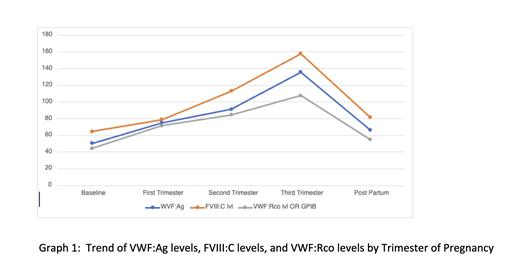Introduction:
Pregnancy is considered a hypercoagulable state, with levels of multiple coagulation factors including Factor VIII (FVIII) and von Willebrand Factor (VWF), progressively increasing throughout, reaching their peak levels during the third trimester. However, in women with von Willebrand disease (VWD), these changes are variable and could be blunted or absent due to the wide heterogeneity of phenotypes and pathophysiological mechanisms linked to this disorder, posing a significant clinical challenge. This study aims to describe the trend in the VWF profile in women with VWD during each trimester of pregnancy and in the postpartum period.
Methods:
This is a retrospective single-center study that included adult pregnant women diagnosed with VWD, who were followed at Henry Ford Health between 03/2012 and 11/2022. Patients with other bleeding disorders were excluded from the study. Data on baseline characteristics, including age, race, age at childbirth, and parity were collected. Additional data collected included VWF antigen (VWF:Ag) level, FVIII activity level, and VWF ristocetin cofactor (VWF:Rco) activity during the first, second, and third trimesters, as well as in the postpartum period.
Results:
A total of 33 cases were included in our study. At baseline, the mean VWF:Ag level in our patients was 50.5% (reference range 50%-150%). Compared to baseline, the VWF:Ag level increased by 48.71% in the first trimester, 80.59% in the second trimester, and 168.71% in the third trimester. Postpartum, the VWF:Ag level decreased by 51.29% compared to the third trimester; however, it remained 30.89% higher than baseline levels. While the FVIII level (reference range 50%-150%) was an average of 64.8% at baseline, it increased by 21.91% in the first trimester, 74.23% in the second trimester, and 143.67% in the third trimester, compared to baseline. Postpartum, the FVIII level decreased by 48.45% from the third trimester but remained 25.62% higher than baseline. Additionally, the VWF:Rco level was an average of 44.3% (reference range 51%-215%) at baseline. Compared to baseline, the VWF:Rco level increased by 61.85% in the first trimester, 90.52% in the second trimester, and 142.66% in the third trimester. It decreased by 49.12% postpartum compared to the third trimester but remained 23.48% higher than baseline.
Conclusion:
In women with VWD, VWF:Ag level, FVIII level, and VWF:Rco levels steadily increase during pregnancy, reaching their maximum levels during the third trimester. All three levels decreased in the postpartum period; however, they remain higher compared to baseline at a median follow up of 105 days after delivery.
Disclosures
No relevant conflicts of interest to declare.


This feature is available to Subscribers Only
Sign In or Create an Account Close Modal